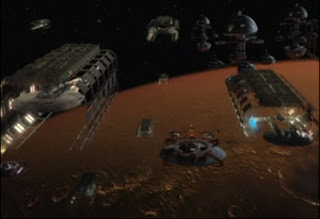Utopia Planitia (Latin: "Nowhere Plain") is the largest recognized impact basin on Mars and in the solar system with an estimated diameter of 3300 km,[1] and is the Martian region where the Viking 2 lander touched down and began exploring on September 3, 1976. It is located at the antipode of Argyre Planitia, centered at 49.7°N 118.0°E. It is in the Casius quadrangle and the Cebrenia quadrangle of Mars.
Many rocks at Utopia Planitia appear perched, as if wind removed much of the soil at their bases.[2][3] A hard surface crust is formed by solutions of minerals moving up through soil and evaporating at the surface.[4] Some areas of the surface exhibit what is called "Scalloped topography," a surface that seems to have been carved out by an ice cream scoop. This surface is thought to have formed by the degradation of an ice-rich permafrost. (Wikipedia) Also known in Star Trek lore, the place for building Federation starships.
 |
| Utopia Planitia shipyards |
Hence, the appropriate title for the following from Scientific American:
In 1993, Americans elected the first physicist to Congress: Vern Ehlers, a Republican from Michigan. Just six years later, former assistant director of Princeton’s Plasma Physics Laboratory, Rush Holt, a Democrat from New Jersey, joined him. And in 2008, Fermilab physicist and Illinois Democrat Bill Foster joined them, only to lose re-election in 2010 before regaining his seat this year. At that rate, Holt joked to an audience of mostly chemists at Princeton University on November 9, “By mid-century, the population of Congress would be physicists.”
But that’s a “slow way” to inject scientific thinking into the political process, Holt argued. “I wish we could get more Americans and, hence, their representatives thinking like scientists, which means basing our conclusions on evidence,” he said.
That laudable goal may prove even more challenging than turning a physicist into an electrifying political speaker. Because humans are not born statisticians, thinking scientifically is both technically and psychologically challenging . We prefer a story (anecdote!) to a compilation of statistics (data!). The modern world, as Holt observed of C.P. Snow’s famous analysis decades ago, has become divided into two disparate camps: scientists and non-scientists.
This may be most apparent currently on the subject of climate change...“The evidence for climate change is strong enough that we should be taking very bold and very expensive action because the costs of not taking action will be even more expensive,” Holt argued, suggesting that legislation to combat climate change “probably will be undertaken again, I would guess relatively soon in the next Congress.”
Scientific American:
Representative Rush Holt's Advice to His Fellow Scientists on Politics
David Biello
Comments